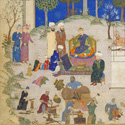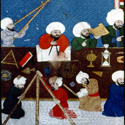About This

|
Lewis observes that during most of
the period 622-1492, Western European civilisation was
definitely inferior to the Islamic, and was, in comparison to it
`underdeveloped.’ This did not just mean, he explains, the
average upper class Muslim felt superior to most Western
Europeans (merchants, warriors, scholars, or priests,) it also
helps explain why, for centuries, Western Europeans were eager
to copy many facets of Muslim culture.[1]The
most important period of passage, however, once more, as Le Bon
stresses, is the 12th and 13th century
period, when, in his words, the luxury of the Orient
with respect to the
military, manner of dress, and home interior, passed West.[2]Many
other forms of cultural influence also passed in that same
period as the following will underline. Before considering some
such passages, however, it is important to dwell a little on two
important matters:
-First, The parameters by which Western Christendom
allowed some of the
Islamic culture to filter through.
-Second, a comment on the expression: luxury in a Muslim
context.
On
the fist point, as Menocal points out, political enmity towards
the Muslims on the part of the `entrenched establishment,’ never
succeeded in mitigating the seductiveness of such Islamic
culture and its numerous attractions for many who emulated them
and believed they had much to offer.[3]
However, because of the sort of relationship that existed
between Muslims and Christians, it was a relationship that is
most likely to produce anxiety, both antagonistic and dependent,
loathed at one level but inescapably influential at many others,
the culture of a world `damned by one's faith yet seeming to be
rewarded by God with affluence and often with stunning military
victories.’[4]
Glick comments on the conflicting elements related to Islamic
cultural impact. Factors influencing selectivity were varied:
economic demand, the market for stylistic innovation, a desire
for new knowledge all contributed to climates favourable to
innovation; hostility, warfare, and religious difference
contributed to a climate that may have been inimical to
borrowing, but only selectively so.[5]Competition
with an enemy can be a powerful stimulus to cultural innovation.
If the barrier is strong enough, such imitation may not be
consciously acknowledged; rather, a process of reinvention may
take place within the recipient culture.[6]
Summing up, Letourneau,
notes that however hostile in principle to Muslim Spain,
Christian Spain would not stop imitating it because the
civilisation of al-Andalus was richer and more sophisticated
than that of the states of Barcelona
,
Aragon, Navarre, Castille, Asturies, and Leon, pursuing that,
similarly Muslim Sicily
and Ifriqyia appeared as
fabulous territories, rich and full of luxury to the Italian
population.[7]
The
second point, talking of luxuries in relation to Islam sounds
misplaced. The concept of excessive material wealth or luxury
has no place in Islam. The idea of the Day of the Judgement `has
always imbued Islam with a humbling spirit,’ Ettinghausen
reminds us.[8]
In view of the pending hour of reckoning, moral deeds have much
higher value than earthly goods with which to embellish life,
and artfully made objects of daily life, are only symbols of
worldly splendour or ostentatious luxury, which can easily
corrupt.[9]
The Hadith (Islamic tradition), thus, states:
`he who drinks from gold
and silver vessels, drinks the fire of hell,'
Hence Islam shuns
luxury, and never found ground for jewelled, gold or silver
vessels, even within the mosque, for the greater glory of God;
thus, there is no parallel whatsoever to the sumptuous objects
in the church treasuries of the Christian Middle Ages.[10]
Islam, Ettinghausen insists, was amply satisfied with the
humblest materials, such as brass, clay, plaster and brick;
cheap material such as stucco used to decorate even the mirhab,
the focal point of the mosque, when the wealth of the community
could have provided the most costly material.[11]
The accumulation of wealth as in the treasuries of the Fatimids
is an exception, and ample evidence for the ebbing morale of the
slowly degenerating dynasty.[12]In
contrast, the second Caliph of Islam, Omar (634-44), owned but
one shirt and one mantle, patched and re-patched; lived on
barley bread and dates, and drank nothing but water; slept on a
bed of palm leaves, hardly better than a hair shirt,[13]
and this while the immense treasures of Byzantium
and Persia were spread
at his feet after both had been vanquished.[14]Thus,
no beakers of precious metal could be used at the courts of the
Muslim state, and earthenware was called to the fore to fulfil
the needs of the highest ranks of Muslim society.[15]
Having, thus, cleared two major issues in relation to the
Islamic cultural impact, such impact is looked at in terms of
its wider definition, with regard to some dominant aspects, but
by no means all aspects.
[1]
A.R. Lewis: The
Islamic World and the West; op cit; p.vii.
[2]
G. Le Bon: La Civilisation des Arabes; op cit; p.259.
[3]
M.R. Menocal: The Arabic Role; op cit; p.65.
[4]
Ibid. p.54.
[5]
T. Glick: Islamic and Christian Spain; op cit; p. 285.
[6]
Ibid.
[7]
R. Letourneau: l'Occident Musulman du VII a la fin du 15
siecle: Annales de l'Institut d'Etudes Orientales,
Alger, Vol 16, 1958, pp 147-176.p.160.
[8]
R. Ettinghausen: The Character of Islamic Art; op cit;
p. 255.
[9]
Ibid.
[10]
Ibid.
[11]
Ibid.
[12]
Ibid.
[13]
W. Durant: The Age of Faith; op cit; p.189.
[14]
J. Glubb: A Short History; op cit; p.84.
[15]
R. Ettinghausen: The Character; op cit; p. 255. |





